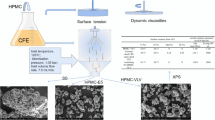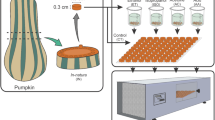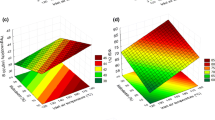Abstract
Spray drying is widely used in the food industry to obtain products in the form of powder (Masters 1991; Filková and Mujumdar 1999; Nijdam and Langrish 2005; Roustapour et al. 2006; León et al. 2010). Three types of modes of contact between drying air and the food product can be found: parallel (co-current), counter-current, or mixed (fountain). The latter is a combination of parallel and counter current flow patterns, which implies that the already dry material comes into contact with drops being sprayed, favoring the formation of agglomerates. In turn, the formation of agglomerates raises the rehydration capacity of the final product (Masters 1991; Vega et al. 2001; Peighambardoust et al. 2011). Although spray drying is a common method used for drying thermolabile materials, there are few reports about the dehydrating conditions used for Aloe vera industrial processing. This plant is widely used in the pharmaceutical, cosmetological, and food areas because of the beneficial effects it provides as a functional ingredient in food and cosmetic products (Simal et al. 2000). However, it has been reported that when gel obtained from the Aloe vera leaf is subjected to thermal processing, changes in its components and functional properties, such as wettability, water retention, and oil adsorption capacity, among others, can occur (Eshun and He 2004; García et al. 2010). Aloe gel contains 98.5 % water, and the remaining solid material consists of polysaccharides, fat, and water-soluble vitamins, minerals, enzymes, phenolic compounds, and organic acids (Bozzi et al. 2007; Eshun and He 2004; Hamman 2008). Several studies have focused on assessing the physical, chemical and functional changes caused by Aloe vera gel processing conditions, especially during dehydration through convective drying (Simal et al. 2000; Femenia et al. 2003; Miranda et al. 2009; García et al. 2010; Gulia et al. 2010). However, to date there is limited data regarding the effect that spray drying temperature has on the physical, calorimetric, and functional characteristics of Aloe vera. Therefore, the objective of this study was to evaluate the effect of spray drying temperatures on obtaining Aloe vera gel in powder form.
Access this chapter
Tax calculation will be finalised at checkout
Purchases are for personal use only
Similar content being viewed by others
Abbreviations
- ANOVA:
-
Analysis of variance
- a w :
-
Water activity
- C G :
-
Energy constant relating to the temperature
- GAB:
-
Guggenheim-Anderson-De Boer equation
- K G :
-
Energy constant relating to the temperature
- μ :
-
Media of the analyzed continuous variable
- M :
-
Moisture content of the powder
- M o :
-
Theoretical water content of the monolayer
- T 1 :
-
Input temperatures
- T 2 :
-
Output temperatures
- T g :
-
Glass transition temperature
- T gm :
-
Mix glass transition temperature
- T gs :
-
Solids glass transition temperature
- T gw :
-
Water glass transition temperature
- X m :
-
Water weight fraction
- X s :
-
Solids weight fraction
- σ :
-
Standard deviation of the analyzed continuous variable
References
AOAC (1997) Official methods of analysis of AOAC International. Gaithersburg, Maryland
Bhandari BR, Howes T (1999) Implication of glass transition for the drying and stability of dried foods. J Food Eng 40:71–79
Bozzi A, Perrin C, Austin S, Arce-Vera F (2007) Quality and authenticity of commercial Aloe vera powders. Food Chem 103:22–30
Cai YZ, Corke H (2000) Production and properties of spray dried Amaranthus betacyanin pigments. J Food Sci 65:1248–1252
Eshun K, He Q (2004) Aloe vera: A valuable ingredient for the food, pharmaceutical and cosmetic industries—a review. Crit Rev Food Sci Nutr 44:91–96
Fang Z, Bhandari B (2011) Effect of spray drying and storage on the stability of bayberry polyphenols. Food Chem 129:1139–1147
Femenia A, García-Pascual P, Simal S, Roselló C (2003) Effects of heat treatment and dehydration on bioactive polysaccharide acemannan and cell wall polymers from Aloe barbadensis Miller. Carbohydr Polym 51:397–405
Filková I, Mujumdar AS (1999) Industrial spray drying systems. In: Mujumdar AS (ed) Handbook of industrial drying, 3rd edn. CRC, New York
Foster KD, Bronlund JE, Paterson AHJ (2006) Glass transition related cohesion of amorphous sugar powders. J Food Eng 77:997–1006
García SP, Mognetti C, Bello A, Martínez MJ (2010) Osmotic dehydration of Aloe vera (Aloe barbadensis Miller). J Food Eng 97:154–160
Gordon M, Taylor JS (1952) Ideal copolymers and the second order transitions of synthetic rubbers. I Noncrystalline copolymers. J Appl Chem 2:493–500
Gulia A, Sharma HK, Sarkar BC, Upadhyay A, Shitandi A (2010) Changes in physicochemical and functional properties during convective drying of Aloe vera (Aloe barbadensis) leaves. Food Bioprod Process 88:161–164
Hamman J (2008) Composition and Applications of Aloe vera leaf gel. Molecules 13:1599–1616
Laroche C, Fine F, Gervais P (2005) Water activity affects heat resistance of microorganisms in food powders. Int J Food Microbiol 97:307–315
León MFM, Méndez LLL, Rodríguez RJ (2010) Spray drying of mucilage (Opuntiaficus-indica): effects on powder properties and characterization. Carbohydr Polym 81:864–870
Masters K (1991) Spray drying handbook. Longman Scientific & Technical, New York
Miranda M, Maureira H, Rodríguez K, Vega-Gálvez A (2009) Influence of temperature on the drying kinetics, physicochemical properties, and antioxidant capacity of Aloe vera (Aloe barbadensis Miller) gel. J Food Eng 91:297–304
Moraga G, Martínez-Navarrete N, Chiralt A (2004) Water sorption isotherms and glass transition in strawberries: influence of pretreatment. J Food Eng 62:315–321
Nijdam JJ, Langrish TAG (2005) An investigation of milk powders produced by a laboratory-scale spray dryer. Dry Technol 23:1043–1056
Ozmen L, Langrish TAG (2002) Comparison of glass transition temperature and sticky point temperature for skim milk powder. Dry Technol 20:1177–1192
Peighambardoust SH, Golshan TA, Hesari J (2011) Application of spray drying for preservation of lactic acid starter cultures: a review. Trends Food Sci Technol 22:215–224
Quek Y, King N, Swedlund P (2007) The physicochemical properties of spray-dried watermelon powders. Chem Eng Process Process Intensif 46:386–392
Roustapour QR, Hosseinalipour M, Ghobadian L (2006) An experimental investigation of lime juice drying in a pilot plant spray dryer. Dry Technol 24:181–188
Sablani SS, Kasapis S, Rahman MS (2007) Evaluating water activity and glass transition concepts for food stability. J Food Eng 78:266–271
Simal S, Femenia A, Llull P, Roselló C (2000) Dehydration of Aloe vera: Simulation of drying curves and evaluation of functional properties. J Food Eng 43:109–114
Tono RV, Brabet C, Hubinger MD (2008) Influence of process conditions on the physicochemical properties of açai (Euterpe oleraceae Mart.) powder produced by spray drying. J Food Eng 88:411–418
van den Berg C, Bruins S (1981) Water activity and its estimation in food systems: theoretical aspects. In: Rockland LR, Stewart GF (eds) Water activity: influence on food quality. Academic, New York, pp 1–61
Vega MH, Góngora NMM, Barbosa CGV (2001) Advances in dehydration of foods. J Food Eng 49:271–289
Welti-Chanes J, Guerrero JA, Barcenas ME, Aguilera JM, Vergara F, Barbosa-Canovas GV (1999) Glass transition temperature (Tg) and water activity (aw) of dehydrated apple products. J Food Process Eng 22:91–101
Acknowledgements
The authors acknowledge the financial support of research projects: SIP 2011745, 20121173, 20111167, 20121754 and CONACyT 84287, as well as the PIFI-program, COFAA-IPN, Tecnológico de Monterrey and CONACyT for study grants.
Author information
Authors and Affiliations
Corresponding author
Editor information
Editors and Affiliations
Rights and permissions
Copyright information
© 2015 Springer Science+Business Media New York
About this chapter
Cite this chapter
García-Luna, I.N., Porras-Saavedra, J., Vergara-Balderas, F., Welti-Chanes, J., Gutiérrez-López, G.F., Alamilla-Beltrán, L. (2015). Defining High and Low Spray Drying Temperatures for Aloe vera Gel. In: Gutiérrez-López, G., Alamilla-Beltrán, L., del Pilar Buera, M., Welti-Chanes, J., Parada-Arias, E., Barbosa-Cánovas, G. (eds) Water Stress in Biological, Chemical, Pharmaceutical and Food Systems. Food Engineering Series. Springer, New York, NY. https://doi.org/10.1007/978-1-4939-2578-0_24
Download citation
DOI: https://doi.org/10.1007/978-1-4939-2578-0_24
Publisher Name: Springer, New York, NY
Print ISBN: 978-1-4939-2577-3
Online ISBN: 978-1-4939-2578-0
eBook Packages: Chemistry and Materials ScienceChemistry and Material Science (R0)




